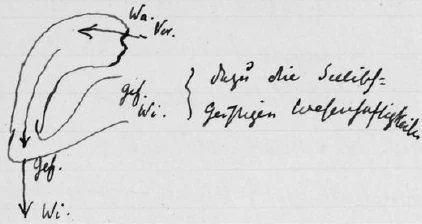Posthumous Essays and Fragments
1879-1924
GA 46
From notebook 4, undated, around 1918.
Translated by Steiner Online Library
101. Conceptual and Volitional Organism
The I as the animating and directing spiritual-soul, which exists in the thought witness; the I is initially embedded in the external and experiences itself in the semicircle of the thought-witnessing power that is unified with the world; thus it sinks into the etheric, in which the ordinary perceptions separate out of the semicircle, and there are the receptive perceptions. The “real self” forms the body of forms, separates from it the etheric body - here a boundary - from the other side the soul and the ego-concept arise. The head: the organ of thinking; physical formation: in it the processes of perception; etheric formation: in it the processes of thinking. Now the respiratory organism: in it the processes of feeling and the limb of will impulses. Then the nutritional organism: the will impulses and the movements.

In the Organism of Imagination: the process of growth has gone beyond itself, entering mineralization: the spirit can be by itself: it comes to inner formation through imagination and partial inspiration: there it is met by inspiration, which becomes perception, and intuition, which becomes cognition.
In the rhythmic organism: it is based on inspiration – which is met by intuition of perception and inspiration of conception from the organism of conception – as negative content, which is fulfilled by positive inspirational content – and remains negative as imagination: this can be fulfilled by
the nourishing organism: this is developed in what the imaginative organism lacks: intuition and part of inspiration: it lacks imagination and part of inspiration.
The non-physical organism: it has within itself intuition and partial inspiration, from which it is closed off by perception and conception; the partial inspiration and imagination, from which it is closed off by feeling and willing.
Through birth, the I emerges from the intuitive and inspirational content of the world in order to intuitively connect with the organism of imagination; this organism is formed by the imagination and inspiration of the spiritual universe. The same forces are at work in it prenatally that arise postnatally in perception and imagination. After death, this imagined and inspired organism is seized by the inspiration and intuition of the spiritual universe. The organism of will: the I enters into the imagined and inspired content of the spiritual universe, connecting with the pictorial forces of the universe, of which the body-self is made.
101. Vorstellungs- und Willensorganismus
Das Ich als belebend und richtend das Geistig-Seelische, das im Gedankenzeugen weset; das Ich ist zunächst im Äußeren eingebettet und erlebt sich im Halbkreis der mit der Welt einheitlichen Gedankenzeugekraft; so senkt es sich in das Ätherische, in dem die gewöhnlichen Vorstellungen sich aus dem Halbkreis aussondern, und da sind empfangend die Wahrnehmungen. - Das «wirkliche Ich» gestaltet den Gestalt-Leib, gliedert aus diesem aus den Ätherleib - hier eine Grenze - von der andern Seite tritt das Seelische und die Ich-Vorstellung auf. Das Haupt: Vorstellungsorganismus physische Bildung: in ihr die Wahrnehmungsvorgänge, ätherische Bildung: in ihr die Vorstellungsvorgänge. Nun der Atmungsorganismus: In ihm Gefühlsvorgänge u. Glied der Willens-Impulse. Dann Ernährungsorganismus: die Willensimpulse und die Bewegungen.

Im Vorstellungsorganismus: Der Wachstumsvorgang ist über sich selbst hinausgetrieben, in die Mineralisierung eingetreten: der Geist kann da für sich sein: er kommt bis zur Innenbildung durch Imagination und teilweise Inspiration: da tritt ihm entgegen die Inspiration, die zur Vorstellung wird und die Intuition, die zur Wahrnehmung wird.
Im Rhythmus-Organismus: es liegt ihm zugrunde die Inspiration - ihr tritt entgegen von dem Vorstellungsorganismus aus die Intuition der Wahrnehmung und die Inspiration der Vorstellung - als negativer Inhalt, der erfüllt wird durch positiven Inspirationsinhalt - und negativ bleibt als Imagination: diese kann erfüllt werden durch den
Ernährungs-Organismus: dieser ist ausgebildet in dem, das dem Vorstellungs-Organismus fehlt: Intuition und ein Teil Inspiration: ihm fehlt die Imagination und ein Teil der Inspiration. —
Der nicht-physische Organismus: er hat in sich: Intuition und teilweise Inspiration, von denen er sich durch die Wahrnehmung und Vorstellung abschließt; die teilweise Inspiration und Imagination, von denen er sich durch Fühlen und Wollen abschließt.
Durch die Geburt tritt das Ich aus dem intuitiven und inspirativen Weltinhalt heraus, um sich intuitiv mit dem Vorstellungsorganismus zu verbinden; dieser Organismus ist eine durch die Imagination und Inspiration des geistigen Universums bewirkte Bildung. Es sind in ihm vorgeburtlich wirksam dieselben Kräfte, die nachgeburtlich in der Wahrnehmung und Vorstellung auftreten - nach dem Tode wird dieses Imaginierte und Inspirierte ergriffen von der Inspiration und Intuition des geistigen Universums. Der Willensorganismus: das Ich tritt in den imaginierten und inspirierten Inhalt des geistigen Universums ein, verbindet sich mit den Bildkräften des Universums, aus denen der Körper-Leib ist.

